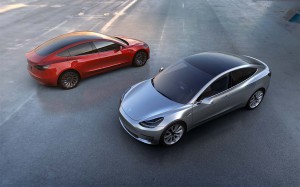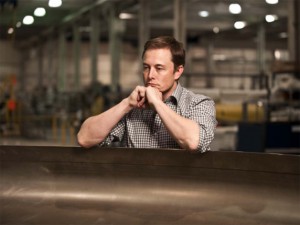
Investors are growing increasingly worried about Tesla's finances, sending its stock tumbling again.
Tesla shares took another sharp dip on Monday, continuing a decline triggered by the maker’s weak fourth-quarter earnings, and the admission by CEO Elon Musk that the battery-carmaker’s finances were “getting very close to the edge.”
Shares were off 4.2% at the end of Monday trading, to $246.23, as Goldman Sachs became the latest to turn on Tesla, analyst David Tamberrino downgrading the maker’s stock from “neutral” to “sell.” The market turned bearish when, last week, Tesla reported that it lost $121.3 million, or 78 cents a share, during the final quarter of 2016.
That might have been taken in a more positive light, considering that was less than half the $320.4 million deficit posted during the fourth quarter of 2015. But Musk struck a cautious note when advising analysts and media during a conference call that the company has been burning through cash at a frantic rate as it prepares to introduce its new Model 3 sedan over the summer.
The Model 3 will make Tesla’s first foray into the mainstream automotive market. And it is expected to yield a massive increase in the company’s overall sales – Musk predicting volume will jump to 500,000 in 2018, or roughly ten times its volume in 2015.
The automaker this month scheduled a temporary closure at its Fremont, California, assembly plant to begin preparing for the launch of Model 3 production, which is scheduled to begin in July. But observers say the sudden dip in Tesla shares reflects significant skepticism about that timing, especially considering the fact that Tesla has not yet hit a single production target with its original Roadster model, as well as the current Models S and X battery vehicles.
Even if the maker does hold to its plan, several analysts have warned – and Musk appeared to agree – it seems increasingly likely the automaker will need another cash infusion before the first Model 3 can roll off the assembly line.

Even Elon Musk acknowledged the company's need for additional capital during its most recent conference call.
Tesla doubled its capital spending during the final three months of the year, a key reason why it remained in the red. The news wasn’t entirely all bad, though, the deficit coming in at less than half that of the year before. Meanwhile, production of Tesla’s two existing models rose 77% during the October-December quarter, while sales jumped 27%.
The Model 3 is the foundation of Tesla’s future strategy, however. At a starting price of around $35,000, or half that of a base Model S, it’s expected to transform Tesla from a niche player into a mainstream manufacturer During the earnings teleconference, Musk reaffirmed a goal of turning out 500,000 vehicles in 2018, a roughly tenfold increase over 2015 production. By 2020, the Tesla CEO declared, the target is a full 1 million.
Not everyone is convinced Tesla will get there, even if it does meet its July deadline. Musk himself acknowledging, “It’s not simple. You’ve got to put these parts together into a car and then you’ve got to deliver these cars. None of these things occur instantaneously.”
Production of the new Model X battery SUV ran well behind schedule for much of 2016, largely due to design and quality snags. Ironically, “Mainstream buyers are going to be a lot less tolerant” than the more affluent customers who have been purchasing the Models S and X, cautioned analyst David Sullivan, of AutoPacific, Inc.
Tesla is betting that higher volumes will offset the lower profit margins on the Model 3, so even a modest shortfall could worsen the company’s cash crunch. About the worst thing that might happen would be to get the same drubbing influential Consumer Reports magazine handed the Model X when it declared the battery SUV,” the sixth least reliable vehicle in our (annual automotive quality) survey,” that was released last November.
(Tesla posts Q4 and full year loss. Click Here for the story.)
Even if all goes well on the manufacturing side, Tesla could face other obstacles. Fond of using blogs and Twitter to outline his vision of the future, Musk has developed a large and loyal fan base. But he surprised many of his followers by agreeing to join the economic advisory council set up by another dedicated tweeter, President Donald Trump.
The two have expressed seemingly polar opposite positions on many environmental issues, Trump going so far as to call global warming a “hoax.” For his part, Musk has defended his new ties to the White House, insisting he will use the forum to help shift the president’s opinion. But there have been reports some customers began canceling advanced reservations for the Model 3 after Trump announced his immigration and travel policies – despite Musk’s public criticism of the so-called Muslim Ban.
During last Wednesday conference call, Musk confirmed some reservations have, indeed, been canceled, though he declined to say how many or identify why. But he did stress that Tesla still has more than 300,000 customers lined up, each having plopped down a $1,000 deposit.
There are other issues worrying investors. That includes the controversial takeover of Solar City, the solar cell company started by several members of the extended Musk family. Despite the CEO’s promise of long-term synergies, some still worry the acquisition will drain not only cash but Elon Musk’s attention.
On Monday, shortly after the New York Stock Exchange closed for the day, Musk announced that his other company, SpaceX, will fly two tourists around the moon in 2018. The rocket firm also has extensive contracts with the U.S. government to supply the International Space Station and to ultimately begin flying astronauts to the station. That would end the dependency upon Russian launches triggered by the end of the U.S. space shuttle program in 2011.
(UAW gearing up for organizing battle with Tesla. Click Here for the story.)
During the earnings call, Musk was asked whether SpaceX is proving a distraction, especially if the Trump Administration ramps up the nation’s space exploration efforts. But the Tesla CEO insisted, “I plan to stay with Tesla forever unless someone kicks me out.”
So far, there are no signs of any such revolt, even after Tesla’s weak earnings report, its likely need for a new infusion of capital, and this past week’s stock slide. But there’s no question that after the giddy ride of the last 12 months that saw Tesla shares hit a 53-week peak of $280.98, caution is now becoming the watchword.
Since going public, Tesla has delivered a profit only twice – and even then using its own, non-GAPP accounting methods. Despite the potential of the Model 3 to turn Tesla into a cash cow, a growing number of analysts following the company have turned bearish in recent days.
Noting that the research firm now expects another loss for 2017 of around $2.15 a share, CFRA analyst Efraim Levy advised Tesla investors this week to go from “Hold” to “Sell.”
“While we see a clearer path towards Model 3 production,” Levy wrote, “we still see execution and other risks to the timing of and achievement of targets.”
(To see more about Tesla’s latest crash controversy, Click Here.)
There’s tremendous upside, he acknowledged, if all goes right, but there’s going to be a lot of nervous guessing between now and July.

I think the dips in Tesla stock needs to be taken into perspective. A 4% dip of a ~$250/share stock is $12.50 so you are still in a great place. Considering buy-in at $50 ~ $70 a person is still doing well. Google and Apple stocks had dipped much more and no one batted an eye.
And to have Goldman once again put it in a “sell” position is a joke, as they have been doing that since day #1.
Unlike the Confederates, the stock shall rise again.